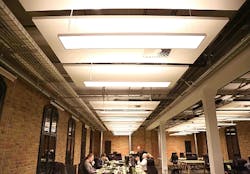We’ve been covering a lot of connected lighting news over the past few years, with functions evolving from “dim the lights” to “find this location and tell me how much energy we’re using in the space.” These developments come from both established lighting manufacturers and companies more famed for their information technologies and services. Certainly, experts in the lighting industry have made it plain that the field is no longer restricted to pure-play lighting companies. Back in January, our colleague James Highgate stated unequivocally that “there are many other capable industries looking to play in our sandbox.”
James noted that misconceptions surrounding smart lighting and the Internet of Things (IoT) could delay or hinder efforts to advance lighting systems beyond general illumination. There have already been some roadblocks during this evolution from illumination to intelligent lighting to smart buildings. Refer to a Strategies in Light 2017 keynote, which Enlighted CEO Joe Costello subtitled “How the lighting industry unwillingly set back the smart building revolution by a decade.” Costello indicated that retrofitting or outfitting new buildings with all-new LED lighting without incorporating truly intelligent sensors was counterproductive, and these issues were often seen as a distribution channel problem that results from a desire to cut costs in building projects.
Lighting is uniquely positioned in its ubiquity to become the central connection point for building IP networks. In case you hadn’t heard, Cisco launched its Digital Ceiling about two years ago, and since then has partnered with a number of lighting and smart technology experts to expand the initiative, which intends to facilitate the uptake of smart lighting and networking components, along with both wired and wireless controls, to equip smart buildings. To that point, even back at Strategies in Light 2015, Cisco VP of IoT vertical solutions Tony Shakib discussed the Digital Ceiling and IoT, and stressed that “if people are changing their lighting to gain efficiency, it's a great time to change technologies and create new outcomes.”
In order to make all these so-called “things” in the IoT obey their technical overlords, we ought to acknowledge the expertise of those who have already been deeply entrenched in digital networks and IP connectivity. We are doing just that with our next webcast on August 22. We will welcome Cisco technical leader Luis Suau, who will take us through the whats, whys, and hows of connecting building elements in a smart lighting-based system. Register for the webcast and learn where to start in making buildings work smarter for owners and occupants.
Clearly, there are professionals with insight and expertise who agree that the convergence of lighting and networking technologies brings benefits to multiple industries — as well as those who are smart enough to leverage this vision into present opportunity. As James Highgate also concluded in a prior blog, “The decisions made today will become paramount to the future of the illumination business.”







